'The Character of the Man in Black' by Oliver Goldsmith
traveler1116 / Getty Images
- An Introduction to Punctuation
- Ph.D., Rhetoric and English, University of Georgia
- M.A., Modern English and American Literature, University of Leicester
- B.A., English, State University of New York
Best known for his comic play "She Stoops to Conquer" and the novel "The Vicar of Wakefield," Oliver Goldsmith was also one of the most prominent essayists of the 18th century. "The Character of the Man in Black" (originally published in the Public Ledger) appears in Goldsmith's most popular essay collection, "The Citizen of the World."

Who Is the Man in Black?
Though Goldsmith said that the Man in Black was modeled on his father, an Anglican curate, more than one critic has observed that the character "bears a striking resemblance" to the author:
In fact, Goldsmith himself seems to have had difficulty reconciling his philosophic opposition to charity with his own tenderness toward the poor--the conservative with the man of feeling. . . . As foolishly "luxurious" as Goldsmith may have considered [the Man in Black's] behavior, he apparently found it natural and almost unavoidable for a "man of sentiment." (Richard C. Taylor, Goldsmith as Journalist . Associated University Presses, 1993)
After reading "The Character of the Man in Black," you may find it worthwhile to compare the essay with Goldsmith's "A City Night-Piece" and with George Orwell's "Why Are Beggars Despised?"
'The Man in Black'
To the Same.
1 Though fond of many acquaintances, I desire an intimacy only with a few. The Man in Black, whom I have often mentioned, is one whose friendship I could wish to acquire, because he possesses my esteem. His manners, it is true, are tinctured with some strange inconsistencies; and he may be justly termed a humorist in a nation of humorists. Though he is generous even to profusion, he affects to be thought a prodigy of parsimony and prudence; though his conversation be replete with the most sordid and selfish maxims , his heart is dilated with the most unbounded love. I have known him profess himself a man-hater, while his cheek was glowing with compassion; and, while his looks were softened into pity, I have heard him use the language of the most unbounded ill-nature. Some affect humanity and tenderness, others boast of having such dispositions from nature; but he is the only man I ever knew who seemed ashamed of his natural benevolence. He takes as much pains to hide his feelings, as any hypocrite would to conceal his indifference; but on every unguarded moment the mask drops off, and reveals him to the most superficial observer.
2 In one of our late excursions into the country, happening to discourse upon the provision that was made for the poor in England, he seemed amazed how any of his countrymen could be so foolishly weak as to relieve occasional objects of charity, when the laws had made such ample provision for their support. "In every parish-house," says he, "the poor are supplied with food, clothes, fire, and a bed to lie on; they want no more, I desire no more myself; yet still they seem discontented. I am surprised at the inactivity of our magistrates in not taking up such vagrants, who are only a weight upon the industrious; I am surprised that the people are found to relieve them, when they must be at the same time sensible that it in some measure encourages idleness, extravagance, and imposture. Were I to advise any man for whom I had the least regard, I would caution him by all means not to be imposed upon by their false pretences; let me assure you, sir, they are imposters, every one of them; and rather merit a prison than relief."
3 He was proceeding in this strain earnestly, to dissuade me from an imprudence of which I am seldom guilty, when an old man, who still had about him the remnants of tattered finery, implored our compassion. He assured us that he was no common beggar, but forced into the shameful profession to support a dying wife and five hungry children. Being prepossessed against such falsehoods, his story had not the least influence upon me; but it was quite otherwise with the Man in Black: I could see it visibly operate upon his countenance, and effectually interrupt his harangue. I could easily perceive, that his heart burned to relieve the five starving children, but he seemed ashamed to discover his weakness to me. While he thus hesitated between compassion and pride, I pretended to look another way, and he seized this opportunity of giving the poor petitioner a piece of silver, bidding him at the same time, in order that I should hear, go work for his bread, and not tease passengers with such impertinent falsehoods for the future.
4 As he had fancied himself quite unperceived, he continued, as we proceeded, to rail against beggars with as much animosity as before: he threw in some episodes on his own amazing prudence and economy, with his profound skill in discovering impostors; he explained the manner in which he would deal with beggars, were he a magistrate; hinted at enlarging some of the prisons for their reception, and told two stories of ladies that were robbed by beggarmen. He was beginning a third to the same purpose, when a sailor with a wooden leg once more crossed our walks, desiring our pity, and blessing our limbs. I was for going on without taking any notice, but my friend looking wistfully upon the poor petitioner, bid me stop, and he would show me with how much ease he could at any time detect an impostor.
5 He now, therefore, assumed a look of importance, and in an angry tone began to examine the sailor, demanding in what engagement he was thus disabled and rendered unfit for service. The sailor replied in a tone as angrily as he, that he had been an officer on board a private ship of war, and that he had lost his leg abroad, in defence of those who did nothing at home. At this reply, all my friend's importance vanished in a moment; he had not a single question more to ask: he now only studied what method he should take to relieve him unobserved. He had, however, no easy part to act, as he was obliged to preserve the appearance of ill-nature before me, and yet relieve himself by relieving the sailor. Casting, therefore, a furious look upon some bundles of chips which the fellow carried in a string at his back, my friend demanded how he sold his matches; but, not waiting for a reply, desired in a surly tone to have a shilling's worth. The sailor seemed at first surprised at his demand, but soon recollected himself, and presenting his whole bundle, "Here master," says he, "take all my cargo, and a blessing into the bargain."
6 It is impossible to describe with what an air of triumph my friend marched off with his new purchase: he assured me that he was firmly of opinion that those fellows must have stolen their goods who could thus afford to sell them for half value. He informed me of several different uses to which those chips might be applied; he expatiated largely upon the savings that would result from lighting candles with a match, instead of thrusting them into the fire. He averred, that he would as soon have parted with a tooth as his money to those vagabonds, unless for some valuable consideration. I cannot tell how long this panegyric upon frugality and matches might have continued, had not his attention been called off by another object more distressful than either of the former. A woman in rags, with one child in her arms, and another on her back, was attempting to sing ballads, but with such a mournful voice that it was difficult to determine whether she was singing or crying. A wretch, who in the deepest distress still aimed at good-humour, was an object my friend was by no means capable of withstanding: his vivacity and his discourse were instantly interrupted; upon this occasion his very dissimulation had forsaken him. Even in my presence he immediately applied his hands to his pockets, in order to relieve her; but guess his confusion, when he found he had already given away all the money he carried about him to former objects. The misery painted in the woman's visage was not half so strongly expressed as the agony in his. He continued to search for some time, but to no purpose, till, at length recollecting himself, with a face of ineffable good-nature, as he had no money, he put into her hands his shilling's worth of matches.
- 'On National Prejudices' by Oliver Goldsmith
- New Year's Eve, by Charles Lamb
- Overview of The Holy Night by Selma Lagerlöf
- Walking Tours, by Robert Louis Stevenson
- On Laziness by Christopher Morley
- "The Black Cat" Study Guide
- Classic British and American Essays and Speeches
- 12 Classic Essays on English Prose Style
- 'Down and Out in Paris and London' Study Guide
- epimone (rhetoric)
- 'Death of a Salesman' Quotes
- By the Railway Side, by Alice Meynell
- Classic Monologue from "Oedipus the King"
- Thoreau's 'Walden': 'The Battle of the Ants'
- How to Apologize: Say "I'm Sorry" With Quotes
- How to Ask Questions for Advanced Students
The Man in Black
By: oliver goldmith, man in black by oliver goldsmith.

of how “he is the only man I ever knew who seemed ashamed of his natural benevolence.”
First Paragraph:
The man is a charitable man. He cares about others, gives to others, and shares with others, but he pretends to not care about the well-being of others. He is “ashamed of his natural benevolence.” While he pretends to have a disliking for mankind, he’s not very good at pretending to be. The author reveals that his poker face is not up to par. “… While his looks were softened into pity, I have heard him use the language of the most unbounded ill-nature.”
Second Paragraph : The “Man in Black” is so concerned with the place of the poor, that he complains to the author of how ignorant the countrymen, or wealthy, are to the state of living of the poorer people. He says that the poor only want a few things – food, housing, clothes, and warmth but cannot obtain those things due to the negligence of the fortunate.
Third Paragraph: The man in black gives a beggar a piece of silver, but when doing so, he appeared “ashamed” to present his weakness to the author; the man has too much pride to show his soft spot for the less fortunate.
Fourth paragraph: When a man with a wooden leg passed the author and the man in black, the author ignored him. The man in black showed much attention to him, but instead of giving him alms, he called him out to be a poser of the needy. But once hearing the sailor’s story of fighting in defense of the country while others “did nothing at home”, the man gave alms to him.
Fifth paragraph: The man in black and the author ran into a woman who was an obvious example of helpless, but he had no money to give her. He became shameful, as it was presented in his face, but once he found a “shilling’s worth of matches”, and placed it in her hands, he was pleased with himself seeing the smile in the woman’s face. This anonymous man, the Man In Black, is a man of benevolence, and is bluntly shameful of it. There is no understanding of why.
The man is one who cannot exhibit generous behavior without being ashamed of it. He wants the world to see him as a man who does not care too much about the well-being of others; much less, the unfortunate. He is the “Man In Black”, because he hides his benevolence. He does not want to be noticed for it. He is, the Man in Black.
Share this:
9 thoughts on “ man in black by oliver goldsmith ”.
I believe that this essay is a well organized essay reflecting on many of the characteristics in society and the many views of people in that society. Just from the picture it could be observed that the author used the man as a metaphor. The man is covered by a white cloth while his body is black which shows the two sides to his personality. This example is very intricate when describing the issues of not only the character but also the author who is portraying the character throughout. Overall, the essay allows me to think that the author shows the views of society and that affects the image and his perception of his self in his own society, and also the time period and how that impacts his personal image in that society. The essay is very detailed and makes me as a knower want to inform myself and read this book.
Thank you Franklin. That made me feel like I did a decent job. And your comment made me think also, because many people are like that- they want to help others, but feel like they will be not accepted by society if they do so.
I’ve read this essay two years ago for my junior year in high school and I have to say I couldn’t agree more on your detailed response and opinion’s.
the man is suffering some kind of psychological problems which he is not able to express. when he when he shows benevolence towards the beggars and poor people who are in need, he is shamed . means that he must have encountered a poor person in the past and something occurred which caused him to compromise, which might explain his strange behavior. it seems as though he’s guilty about something he did
I thought of that as I was reading it, but I didn’t have a way of backing it up.
Well constructed essay with informative prose. I liked how the examples were structured and this evidence supported each claim.
Excellent analysis of the essay without over done conjecture.
Leave a comment Cancel reply

- Already have a WordPress.com account? Log in now.
- Subscribe Subscribed
- Copy shortlink
- Report this content
- View post in Reader
- Manage subscriptions
- Collapse this bar
- Privacy Policy
- Terms and Conditions

- Short Stories
- Literary Essays
Galaxy English Lit Display Ad 1
Essay the man in black by goldsmith—summary, introduction of the essay:.
In the essay, The Man in Black , the writer presents a true picture of the society of his age. His society was the victim of many shortcomings. It was broken economically and morally. Due to the worst economic state, the common people were reduced to the state of beggary. The writer believed in indirect reform, so he, in the essay, introduces the character of the man in black. He presents him as his best friend.
Summary of the Essay:
Although the writer was great fond of making friends and developing intimacy, yet he had intimacy with a few persons. He was extremely happy to be the friend of the Man in Black. The man in black always found a special place in the heart of the writer. The nature of the man in black was abnormal. He had some strange qualities. He was a humorist. In spite of being a generous and kind - hearted, he tried his best to conceal his noble qualities. He felt ashamed in revealing his noble qualities. Outwardly he looked stern and a wonderful example of stinginess and wisdom, but within his heart, a stream of humanity flowed. His heart was filled with boundless love but his conversation expressed mean merciless thoughts. Some pretend to show that they are great embodiment of humanity and they also present themselves as the great well - wishers of human beings. They show their false generosity. There are also many others who boast of their noble virtues and whenever they get opportunity, they expose themselves publicly. But the man in black was the only man that felt great ashamed to have natural benevolence. He took as much pains to hide his feelings as any hypocrite would do to conceal his callousness. But his feelings of kindness and generosity were so dominant and expressive that they could not be easily concealed. Whenever he was not on guard, his real feelings were exposed and even an ordinary observer could notice his real feelings. During this visit, the writer and the man in black began to talk about the provision that was made for the poor in England. The man in black seemed surprised how people had become so foolish as to help the beggars, while the p government had made sufficient arrangements for the poor. He told the writer that in every parish house, the poor were supplied bed, fire, clothes and food free of cost. In the opinion of the man in black, it was sufficient to fulfil their needs. If he were at their place, he would desire no more. He was greatly surprised at their discontentment. He condemned the judicial system which was extently responsible in increasing the number of the vagrants and these vagrants were the burden upon the hard working people. He also condemned those who were encouraging idleness, extravagance and imposture. They deserved a prison in place of help.
When the man in black was discouraging the writer from helping the beggars, just then an old man who was wearing rags of fine clothes, appeared before them and requested to have pity on him. He convinced them that he was not an ordinary beggar, but he was forced into beggary because of his dying wife and five hungry children. His story could not make any influence upon the heart of the writer, but the man in black was moved with pity. The false story of that old man created a sort of commotion in the heart of the man in black. The expression of mercy was clearly visible at his face. He wanted to relieve his five starving children, but he did not want to do so in the presence of his friend. Just for a moment, the narrator pretended to look another way, the man in black gave a silver coin into the beggar's hand secretly and warned him to work hard for his family in place of making trouble for passengers. The man in black was under this impression that nobody had seen him helping the old man. They moved forward and the man in black continued to utter reproaches against the beggars and vagabonds. He told the writer that he had great practical wisdom and he was able to find out if the beggar was real or cheating. He told about women robbed by beggars. He had hardly finished his speech against the cheating beggars when a sailor with a wooden leg appeared before them. He also desired for their pity. The writer, without taking any notice at him advanced. But the man in black stopped there. He called the writer and told him that he would show him (the writer) how he could detect an impostor at any time.
The man in black assumed a serious look and in a stern voice he asked the sailor how he became disabled for the service. The sailor replied in the same tone that he was an officer on a private ship of war. He had lost his leg in defending those who did nothing at home. He was full of bitterness because he received no pension or compensation for the loss of his limb. He was left to his fate to die or live on beggary. On hearing the pathetic story of the sailor, the importance of the man in black at once disappeared. Now, he had nothing to ask him more. He wanted to relieve him in any way and he began to think the method of helping him so that he might be unobserved. He threw his furious glance on the match boxes which the sailor carried in a string at his back. The man in black asked him the price and condition of selling the matches, but he did not wait sailor's reply and settled the bargain himself. The man in black offered the sailor only one shilling. The sailor accepted one shilling gladly and he was also happy with this deal because the man in black had purchased a cheap thing at higher cost. To prove the utility of his purchased matches, the man in black gave many arguments that the matches were very cheap. He gave a detailed account upon the savings from lighting the candles with a match instead of throwing them into fire. The man in black continued his speech on thrift and matches until his attention was attracted by a beggar woman whose condition was more pathetic than the former beggars. The woman in rags had a child in her lap and another on her back. Even in such a miserable condition, she was trying to entertain others by singing songs. Her voice was mournful, so it was difficult to determine whether she was singing or crying. Her appeal was so pathetic that the man in black was unable to resist her under any circumstance. His conversation was constantly interrupted by the frequent appeals of the woman for help with the result that his mask of stiffness dropped off and he was once again in his real self. Without caring the presence of the writer, he immediately applied his hands to his pockets in order to relieve her, but he had spent his whole money on the former two beggars. After being failure to find any shilling in his pockets, the man in black became more miserable than the woman herself. His pain and tension were clearly visible over his face. Seeing no way to help her, he gave those bundles of matches which he had bought from the sailor with a wooden leg.
You may like these posts
Search posts, popular posts.
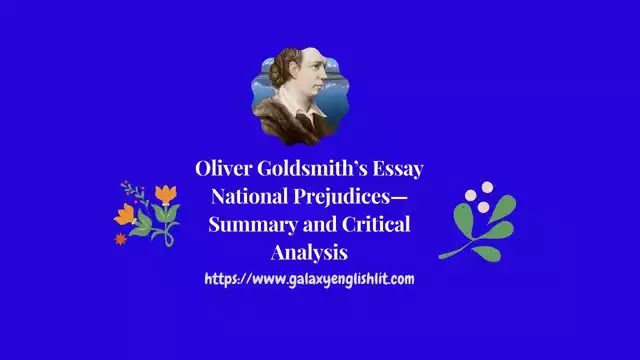
Essay On National Prejudices by Goldsmith—Summary and Critical Analysis

Essay The Man in Black, A Reflection of People’s Economic Condition in 18th Century England
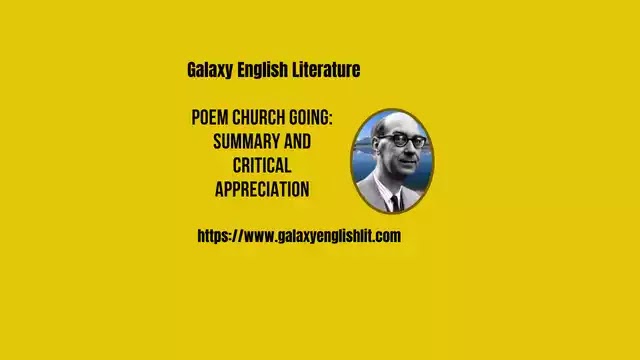
Poem Church Going: Summary and Critical Appreciation

Discuss Shaw’s Candida As A Serious Comedy
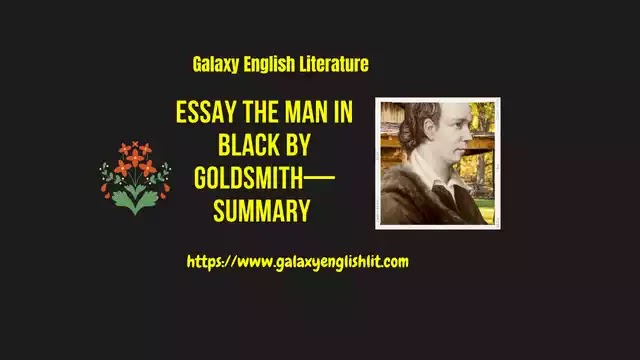
- After Blenheim 2
- All My Sons 2
- Art of Story Telling 1
- Arthur Miller 2
- Break Break Break 1
- Church Going 1
- Daffodils 1
- Ernest Hemingway 2
- G M Hopkins 2
- Harold Pinter 4
- Hawk Roosting 1
- Hearts and Hands 2
- Henry Cuyler 2
- James Patrick Kinney 2
- Jane Austen 5
- John Donne 1
- John Keats 4
- Judicious Flattery 1
- Literary Essays 6
- National Prejudices 1
- Neutral Tones 1
- Old Man at the Bridge 2
- Oliver Goldsmith 4
- Oliver Twist 1
- Philip Larkin 6
- Poetry of Departure 1
- Poets and Writers 65
- Present in Absence 1
- Pride and Prejudice 5
- Robert Browning 1
- Robert Southey 2
- Sailing to Byzantium 1
- Short Stories 4
- Sir Richard Steele 3
- T S Eliot 9
- Ted Hughes 6
- The Caretaker 4
- The Cold Within 2
- The Family Reunion 3
- The Heart of the Tree 2
- The Journey of the Magi 1
- The Man in Black 3
- The Mayor of Casterbridge 3
- The Patriot 1
- The Second Coming 1
- The Tempest 5
- The Thought Fox 1
- The Unknown Citizen 1
- The Wanderer 1
- Thomas Hardy 9
- To The Moon 1
- True Love 1
- W. B. Yeats 5
- W.H. Auden 2
- William Blake 1
- William Shakespeare 9
- William Wordsworth 2
Most Recent
Footer copyright, contact form.
Search Suggest

Class with Mason - School of Literary Studies
- Full Courses
- Poetry Analysis
- Notes on Novels
- Drama Notes
- Prose Notes
- Biographies
- Literary Terms
- Literary Theory
- Bridge of Faiths
- Mobile-First Slides
- Sub Menu 03
- Sub Menu 04
- Sub Menu 05

The Man in Black by Oliver Goldsmith: 20 Questions & Answers
The essay "The Man in Black" serves as a powerful critique of the societal shortcomings prevalent during Oliver Goldsmith's era. Through the character of the "Man in Black," Goldsmith exposes the contradictions and hypocrisies within society, particularly concerning the treatment of the impoverished and marginalized. The essay serves as a poignant commentary on the moral and economic decay of the period, advocating for a more empathetic and compassionate approach to societal issues.
Goldsmith employs the character of the "Man in Black" as a means to challenge the prevalent societal norms and expose the contradictions within human behavior. By showcasing the character's seemingly contradictory traits, Goldsmith emphasizes the disparity between public appearances and private actions, highlighting the need for a more nuanced understanding of human nature. The "Man in Black" serves as a vehicle for Goldsmith to advocate for greater empathy and compassion in society..
The "Man in Black" is a paradoxical character, embodying qualities that contradict his outward demeanor. Despite appearing austere and uncharitable, he harbors a deep sense of kindness and generosity. This paradox serves as a reflection of the societal contradictions prevalent during Goldsmith's time, illustrating the disparity between public perceptions and private realities. Goldsmith utilizes this contrast to underscore the need for a more holistic understanding of human nature and the complexities underlying societal attitudes..
Irony plays a pivotal role in "The Man in Black," highlighting the incongruity between the character's public pronouncements and private actions. The use of irony serves to underscore the hypocrisy and moral ambivalence present in societal attitudes toward the less fortunate. Goldsmith employs irony to critique the prevailing judgments and stereotypes that often overshadow genuine human compassion, emphasizing the need for a more sincere and empathetic approach to social issues.
The "Man in Black" serves as a representation of the multifaceted aspects of human nature, highlighting the coexistence of both generosity and apparent stinginess within an individual. Goldsmith uses this character to showcase the intricate interplay between outward appearances and underlying motivations, underscoring the nuanced understanding required to grasp the complexities of human behavior and societal attitudes. The "Man in Black" embodies the intricate blend of contradictions that define human nature, prompting readers to reconsider their preconceived notions and judgments..
Goldsmith employs the character of the "Man in Black" as a symbol of societal critique, using his actions and interactions to shed light on the prevailing societal attitudes and contradictions. The "Man in Black" serves as a lens through which Goldsmith highlights the disparity between public judgments and private compassion, emphasizing the need for a more empathetic and humane approach to societal issues. Goldsmith's portrayal of the "Man in Black" serves as a call for greater introspection and understanding of the complexities underlying societal norms..
The character of the "Man in Black" serves as a poignant portrayal of empathy and compassion within an individual constrained by societal norms. Despite his outward appearance of indifference, the "Man in Black" exhibits profound kindness and generosity in his actions, highlighting the inherent human capacity for compassion. Goldsmith utilizes the character to emphasize the importance of empathy and understanding in the face of societal hardships, advocating for a more compassionate and humane approach to societal issues..
Goldsmith uses the character of the "Man in Black" as a lens through which to highlight the pervasive moral decay and economic hardships prevalent within society. Through the character's interactions with the impoverished and marginalized, Goldsmith sheds light on the complexities of societal struggles and the challenges faced by those at the fringes of society. The "Man in Black" serves as a representation of the societal contradictions, urging readers to reflect on the underlying issues of moral and economic decay that require a more empathetic and compassionate approach..
Goldsmith employs a nuanced narrative technique in "The Man in Black" to underscore the societal critique embedded within the essay. Through the use of a complex and paradoxical character, Goldsmith weaves a narrative that highlights the intricacies of societal attitudes and human behavior. The narrative technique serves to emphasize the disparity between public perceptions and private actions, urging readers to delve deeper into the complexities of societal norms and individual motivations. Goldsmith's narrative technique serves as a powerful tool to provoke introspection and reflection on the societal issues presented in the essay..
The "Man in Black" serves as a significant literary device in Goldsmith's essay, functioning as a conduit for societal critique and introspection. Through the character's paradoxical nature, Goldsmith exposes the contradictions within societal norms and human behavior, prompting readers to reconsider their preconceived notions and biases. The "Man in Black" serves as a powerful tool to evoke empathy and understanding, highlighting the complexities of human nature and the need for a more compassionate and empathetic approach to societal issues..
The character of the "Man in Black" serves as a reflection of Goldsmith's commentary on the shortcomings of societal values and norms prevalent during his era. Through the character's interactions and contradictions, Goldsmith critiques the prevailing attitudes toward the impoverished and marginalized, highlighting the disconnect between societal expectations and genuine human compassion. The "Man in Black" serves as a vehicle for Goldsmith to advocate for a more empathetic and humane approach to societal issues, challenging the established norms and values of his time..
The "Man in Black" plays a crucial role in challenging the readers' perceptions of societal attitudes and human nature by embodying a complex and contradictory character. Goldsmith utilizes the character to challenge the readers' preconceived notions and biases, prompting them to reconsider their judgments and assumptions. The "Man in Black" serves as a catalyst for introspection, encouraging readers to delve deeper into the complexities of human behavior and the societal contradictions that underlie prevalent attitudes and norms.Explain how the "Man in Black" serves as a vehicle for Goldsmith to advocate for social change and compassion..
The "Man in Black" serves as a powerful vehicle for Goldsmith to advocate for social change and compassion within society. Through the character's actions and interactions, Goldsmith highlights the need for a more empathetic and humane approach to societal issues, urging readers to reconsider their attitudes toward the less fortunate. The "Man in Black" embodies the potential for societal transformation, prompting readers to reflect on the importance of compassion and understanding in addressing the prevailing moral and economic challenges of the time..
The "Man in Black" significantly impacts the overall message of the essay, serving as a powerful instrument for Goldsmith's societal critique. Through the character's contradictions and interactions, Goldsmith underscores the complexities of societal attitudes and human behavior, emphasizing the need for a more compassionate and empathetic approach to societal issues. The "Man in Black" amplifies the overarching message of the essay, urging readers to reflect on the inherent contradictions within societal norms and advocate for meaningful social change and understanding..
The "Man in Black's" interactions with the old beggar serve as a poignant portrayal of societal attitudes and contradictions. Despite the "Man in Black's" outward disdain for beggars, his compassionate response to the old man's plea highlights the hypocrisy and moral ambivalence prevalent in society. Goldsmith utilizes this interaction to emphasize the stark contrast between public attitudes and private actions, shedding light on the need for genuine empathy and understanding for the plight of the less fortunate..
The narrative structure of "The Man in Black" employs a nuanced approach to underscore the societal critique embedded within the essay. Through a series of encounters and interactions, the narrative gradually unveils the complexities of societal attitudes and human behavior. The structure serves to highlight the contradictions and hypocrisies prevalent in society, prompting readers to delve deeper into the underlying motivations and moral dilemmas faced by the characters. Goldsmith's narrative structure effectively amplifies the impact of the societal critique, compelling readers to reflect on the prevailing societal norms and values..
The "Man in Black" significantly influences the readers' perception of societal morality and compassion by challenging their preconceived notions and biases. Through the character's complex and contradictory nature, Goldsmith prompts readers to reconsider their understanding of societal norms and human behavior. The "Man in Black" serves as a catalyst for introspection, urging readers to reflect on the importance of empathy and compassion in addressing the prevalent moral and economic challenges of the time. Goldsmith's portrayal of the "Man in Black" encourages readers to advocate for a more empathetic and humane approach to societal issues..
Goldsmith uses the character of the "Man in Black" as a vehicle to underscore the need for empathy and understanding within society. Through the character's interactions and contradictions, Goldsmith emphasizes the importance of looking beyond outward appearances and societal expectations to grasp the complexities of human nature. The "Man in Black" serves as a symbol of concealed kindness, prompting readers to consider the significance of genuine compassion and understanding in addressing the societal challenges of the time..
The character of the "Man in Black" embodies the themes of moral ambiguity and societal judgment, highlighting the complexities of human behavior and societal norms. Through the character's contradictory actions and attitudes, Goldsmith critiques the prevalent societal judgments and stereotypes, emphasizing the need for a more nuanced understanding of human nature. The "Man in Black" serves as a reflection of the moral and societal ambiguities prevalent during Goldsmith's era, urging readers to reevaluate their perceptions and biases..
The "Man in Black" significantly impacts the readers' understanding of the complexities of human nature and societal attitudes by challenging their preconceived notions and biases. Through the character's paradoxical nature, Goldsmith prompts readers to delve deeper into the intricacies of human behavior and the societal contradictions that underlie prevalent attitudes and norms. The "Man in Black" serves as a powerful instrument for introspection, urging readers to reconsider their judgments and assumptions, and advocate for a more compassionate and empathetic approach to societal issues..
Ad-Blocker Detected!
Sorry, we detected that you have activated Ad-Blocker. Please consider supporting us by disabling your Ad-Blocker, it helps us in developing this Website. Thank you!
(Stanford users can avoid this Captcha by logging in.)
- Send to text email RefWorks EndNote printer
Goldsmith : selected essays
Available online, at the library.

Green Library
More options.
- Find it at other libraries via WorldCat
- Contributors
Description
Creators/contributors, contents/summary.
- Introduction
- 1. 'English Pride'
- 2. 'Characteristics of Different Countries'
- 3. 'A Visit to Westminster Abbey'
- 4. 'The Character of the Man in Black'
- 5. 'The History of the Man in Black'
- 6. 'A Description of a Club of Authors'
- 7. 'The Proceedings of the Club of Authors'
- 8. 'Sights and Monsters'
- 9. 'A Bookseller's Visit'
- 10. 'The Character of Beau Tibbs'
- 11. 'A Visit to Beau Tibbs'
- 12. 'Happiness and Show'
- 13. 'Mad Dogs'
- 14. 'An Evening at Vauxhall'
- 15. 'A Little Great Man'
- 16. 'Anecdotes of Poets'
- 17. 'Imitation in Literature'
- 18. 'The Courts of Justice'
- 19. 'A Coronation'
- 20. 'Funeral Elegies'
- 21. 'Finding Famous Men'
- 22. 'A City Night-Piece'
- 23. 'Travellers' Tales'
- 24. 'A Reverie'
- 25. 'The Sentiments of a Frenchman on the Temper of the English'
- 26. 'The Characteristics of Greatness'
- 27. 'An Account of the Augustan Age of England'
- 28. 'National Prejudices'
- 29. 'Adventures of a Strolling Player'
- 30. 'On the Use of Language'
- 31. 'Independence'
- 32. 'At the Play'
- (source: Nielsen Book Data)
Bibliographic information
Acquired with support from.

The Catherine W. and Howard M. Avery Book Fund
Browse related items
- Stanford Home
- Maps & Directions
- Search Stanford
- Emergency Info
- Terms of Use
- Non-Discrimination
- Accessibility
© Stanford University , Stanford , California 94305 .
- Find a Library
- Browse Collections
- 'The Man in Black' by Oliver Goldsmith
audiobook (Unabridged) ∣ (With a Brief Introduction)
By m. venkataraman.
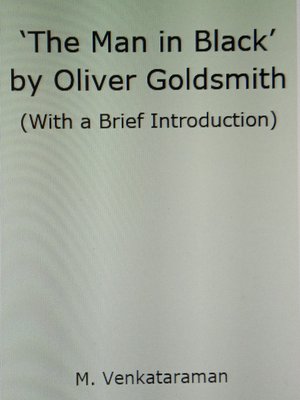
Add Book To Favorites
Is this your library?
Sign up to save your library.
With an OverDrive account, you can save your favorite libraries for at-a-glance information about availability. Find out more about OverDrive accounts.
M. Venkataraman
M. VENKATARAMAN
26 January 2022
Find this title in Libby, the library reading app by OverDrive.

Search for a digital library with this title
Title found at these libraries:.
Oliver Goldsmith was a famous English writer. Among his writings is a prose collection of essays titled "The Citizen of the World". The "The Man in Black" is a piece of writing from this collection of essays. In this essay, Goldsmith makes a mockery of the then contemporary society. He attacks the social and political situation that dominated during Anglo-Saxon period in England.
Goldsmith subtly discourages some of the deficiencies of the then society through this article. Through this writing he mocks at the society for exhibiting the trend of showing 'what you are not'. In a subtle way he ridicules the pretentiousness of the society by portraying a contrasting character. The Man in Black is a character created by Goldsmith for this purpose. The mockery of the then society is exhibited through a routine walk and conversation between the Man in Black and his friend.
The Man in Black is a very interesting character. He is inconsistent. He does not practice what he preaches. He is a kind, sympathetic, and genial person with a compassionate heart. Outwardly, however, he seems unkind, looking like a rude, curt, and stern person. This is in contrast with his inner personality. Goldsmith is mentioning this man as the 'Man in Black' because this man seems black outside but white and noble inside.
The Man In The Black Suit

59 pages • 1 hour read
A modern alternative to SparkNotes and CliffsNotes, SuperSummary offers high-quality Study Guides with detailed chapter summaries and analysis of major themes, characters, and more. For select classroom titles, we also provide Teaching Guides with discussion and quiz questions to prompt student engagement.
Story Analysis
Character Analysis
Symbols & Motifs
Literary Devices
Important Quotes
Essay Topics
Discussion Questions
The story takes place in 1914. Besides the onset of World War I in 1917, what other historical events were taking place in the United States at that time?
All Stephen King’s works are set in Maine. However, like Castle Rock, the town of Motton is fictional. In your opinion, why might the author have chosen to set his stories in fictional locations, rather than real ones?
Nathaniel Hawthorne’s story “Young Goodman Brown” inspired “The Man in the Black Suit.” Read Hawthorne’s story and compare or contrast three elements not discussed in this guide.

Don't Miss Out!
Access Study Guide Now
Related Titles
By Stephen King

Stephen King

Bag of Bones
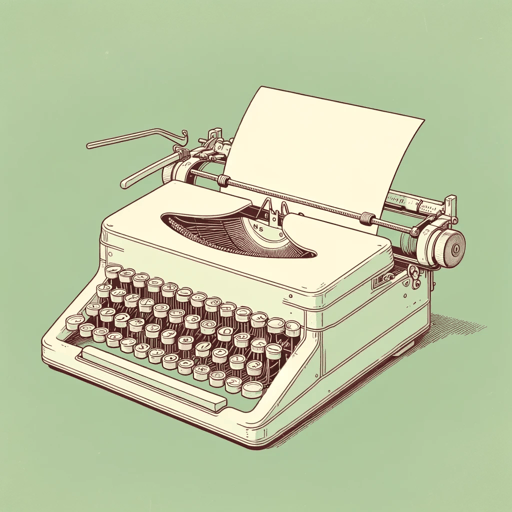
Billy Summers
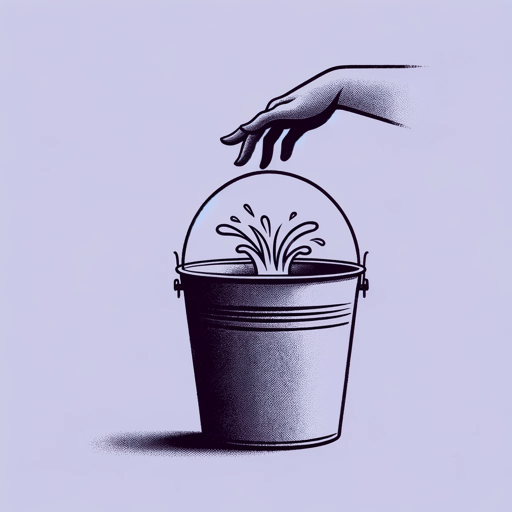
Children of the Corn

Different Seasons
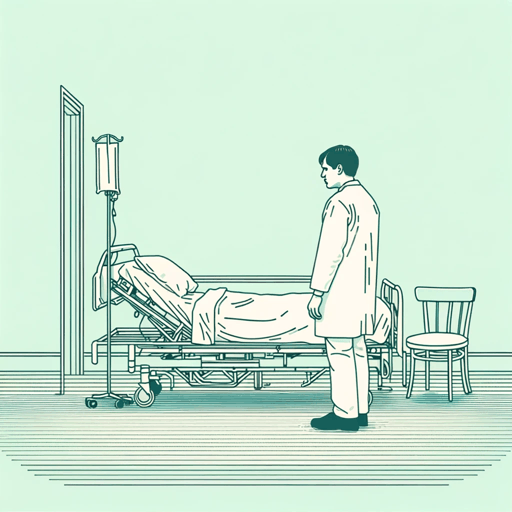
Doctor Sleep
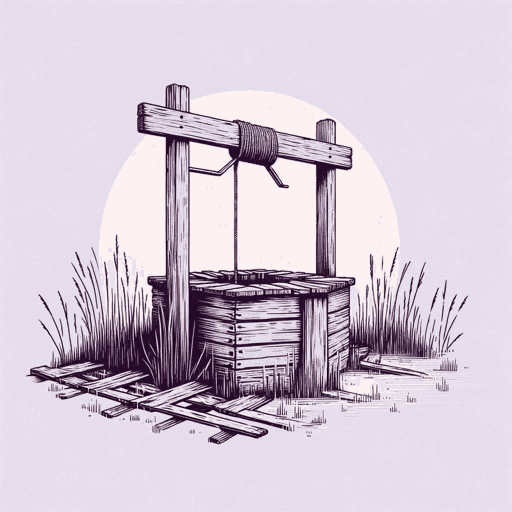
Dolores Claiborne

Elevation: A Novel

End of Watch

Finders Keepers
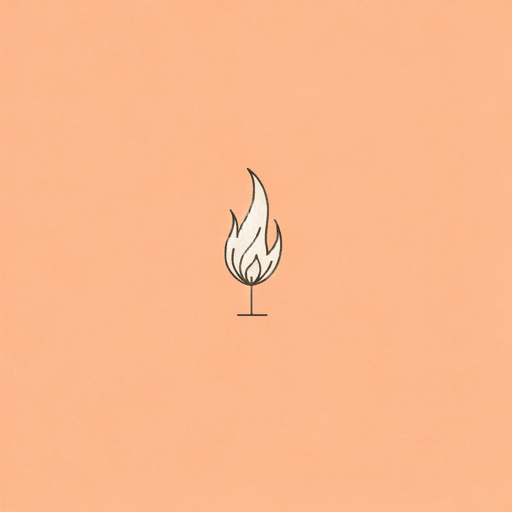
Firestarter

From a Buick 8

Full Dark, No Stars
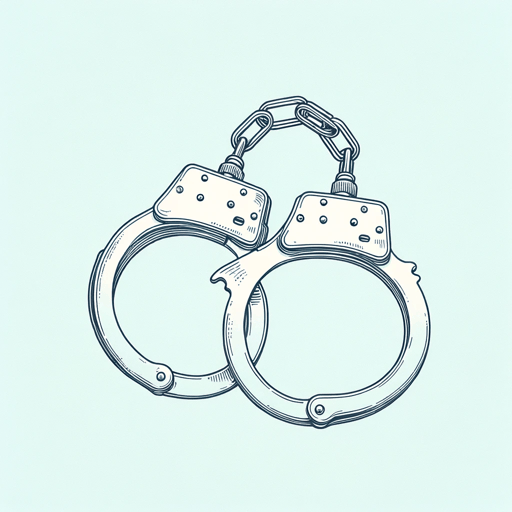
Gerald's Game
Gwendy's Button Box
Stephen King, Richard Chizmar
Featured Collections
View Collection
Mortality & Death
Psychological Fiction
Religion & Spirituality
- 2024 Sexiest Men Of the Moment
- Of The Essence
- Celebrity News
- If Not For My Girls
- The State Of R&B
- Time Of Essence
- SSENSE X ESSENCE
- 2023 Best In Black Fashion Awards
- 2023 Fashion House
- Fashion News
- Accessories
- 2024 Best In Beauty Awards
- Girls United: Beautiful Possibilities
- Relationships
- Bridal Bliss
- Lifestyle News
- Health & Wellness
- ESSENCE Eats
- Food & Drink
- Money & Career
- Latest News
- Black Futures
- Paint The Polls Black
- Essence Holiday Gift Guide 2023
- 2024 Black Women In Hollywood
- 2024 ESSENCE Hollywood House
- 2024 ESSENCE Film Festival
- 2024 ESSENCE Festival Of Culture
- 2023 Wellness House
- 2023 Black Women In Hollywood
- Girls United
WHERE BLACK CULTURE, COMMUNITY AND CONSCIOUSNESS MEET
Sign up for essence newsletters the keep the black women at the forefront of conversation., why i refuse to get work done as a black man in the age of botox and fillers.

“Black don’t crack”– a quote that we’ve all grown up hearing. As a proud Black man who embraces my culture and roots, I idolize this statement whenever I’m having a conversation with my friends. But on the other side of that coin, is the pressure to uphold a forever youthful appearance, even if it isn’t natural.
These days, to stay inspired beauty-wise, I find myself admiring Black celebrities who celebrate their natural skin. However, I have noticed that there is a significant increase in the number of A-listers who are undergoing cosmetic surgery. When I look back at celebrities from previous years, I wonder what motivated or inspired them to undergo these procedures now. Was it to conform to beauty standards or to maintain a youthful appearance?
In today’s day and age, I have noticed that people around my age, or even younger, are getting cosmetic work done. There are many instances where individuals, out of seemingly nowhere, would share that they have had botox, filler, or lip flips to enhance or change their features. I am astonished and curious as to why people my age often resort to cosmetic work. However, I have to remind myself that we live in a time where people are embracing cosmetic procedures, and they are free to do whatever makes them feel good. But it makes me wonder, where do we draw the line between feeling good in our skin and the pressure to uphold certain beauty standards?
The cosmetic industry has seen a significant increase in the number of people opting for procedures such as nose jobs, face lifts, liposuction, breast reduction, fillers, and the like, all aimed at improving their appearance. According to the American Society of Plastic Surgeons , in 2020, over 1.78 million Black individuals received cosmetic work. Due to our extra melanin, Black people often face issues like sagging skin , hyperpigmentation, dark spots, and sunken eyes, which can make them look older. As a result, many of us are turning to cosmetic procedures to address and hopefully get rid of these skincare concerns.
Seeing all of this definitely takes me back to a time in my life when I wanted to get cosmetic work done to remove my big full lips. Unfortunately, I was ostracized and ridiculed for having them. I thought I had to look a certain way to be liked and accepted by others. I thought that I needed to hide my features. Social media has made an impact on the popularity of cosmetic procedures and I, along with many people, began to internalize and create society’s beauty standards.
However, as time passed, I noticed a surge in the number of people from my high school getting fillers on their lips or face. A reminder that trends and beauty standards come and go. In the end, I’m glad I didn’t change what ultimately became praised later. My relationship with beauty shifted and I had to remember, my features make me unique.
As a Black person, we can all relate to feeling overlooked and fetishized for everything. We, as Black men, for example, are told we have to have big muscles, washboard abs, bone structure, a moisturized body, snatched waist, and clear skin. And if you’re gay, you have to make sure everything is put together before you head out of the house. Otherwise, you’ll be “read to filth” by other gay men.
These standards still have me wondering what it would be like to get work done. Would pressures dissolve? How will my face or body react? What will my friends or family say to me when I tell them I got work done? Would they support me? Or would they roast me like Joan, Maya, and Lynn did Toni for getting Botox in that one episode of Girlfriends?
Thoughts such as these pass through my mind. But, even still, I’ve opted for investing in my internal health instead of how I look. I’ve come to the conclusion because this is an expensive enough investment as is, without adding the cost of cosmetic procedures into the mix. For example, I once had to get a dental implant to replace a missing tooth in 2022, which cost me about $7,000 out of pocket. Additionally, I used Smile Direct Club to close the gap between my two front teeth. Although it was a somewhat cosmetic procedure, these experiences taught me that I need to prioritize my health.
At the end of the day, your health is a reflection of you and shines on the outside anyway. All I can do is drink my water, take my vitamins, boost my collagen intake, and mind my business to live a long life. Because what’s a cosmetic procedure done if my quality of life is poor? Or, God forbid, that I don’t live as long to enjoy it due to not taking good care of myself. And some of us can’t afford both.
Moreover, people fearing getting older concerns me. To me, with age comes wisdom, self-confidence, and a new self-awareness. That is what the grown folks’ generation would tell me, anyway.
COMPANY INFORMATION Our Company Customer Service Essence Ventures Change Your Address Contact Us Job Opportunities Internships Media Kit SUBSCRIBE Newsletters Give a Gift of ESSENCE Magazine Tablet Edition FOLLOW US MORE ON ESSENCE Home Love Celebrity Beauty Hair Fashion ESSENCE festival ESSENCE.com is part of ESSENCE Communications, Inc.

- River City Live
- Newsletters
WEATHER ALERT
2 river flood warnings in effect for Brantley and Columbia Counties
Trump lawyers say stormy daniels refused subpoena outside a brooklyn bar, papers left 'at her feet'.
Jake Offenhartz And Michael R. Sisak
Associated Press
FILE - Stormy Daniels appears at an event, May 23, 2018, in West Hollywood, Calif. The hush money trial of former President Donald Trump begins Monday, April 15, 2024, with jury selection. It's the first criminal trial of a former U.S. commander-in-chief. The charges in the trial center on $130,000 in payments that Trump's company made to his then-lawyer, Michael Cohen. He paid that sum on Trump's behalf to keep Daniels from going public, a month before the election, with her claims of a sexual encounter with Trump a decade earlier. (AP Photo/Ringo H.W. Chiu, File)
NEW YORK – Donald Trump’s legal team says it tried serving Stormy Daniels a subpoena as she arrived for an event at a bar in Brooklyn last month, but the porn actor, who is expected to be a witness at the former president's criminal trial , refused to take it and walked away.
A process server working for Trump's lawyers said he approached Daniels with papers demanding information related to a documentary recently released about her life and involvement with Trump, but was forced to “leave them at her feet," according to a court filing made public Wednesday.
Recommended Videos
“I stated she was served as I identified her and explained to her what the documents were,” process server Dominic DellaPorte wrote. “She did not acknowledge me and kept walking inside the venue, and she had no expression on her face.”
The encounter, prior to a screening of the “Stormy” film at the 3 Dollar Bill nightclub, has touched off a monthlong battle between Trump’s lawyers and Daniels' attorney that continued this week as the presumptive Republican nominee's criminal trial began in Manhattan.
Trump's lawyers are asking Judge Juan M. Merchan to force Daniels to comply with the subpoena. In their filing, they included a photo they said DellaPorte took of Daniels as she strode away.
Daniels' lawyer Clark Brewster claims they never received the paperwork. He described the requests as an “unwarranted fishing expedition” with no relevance to Trump's criminal trial.
“The process — instituted on the eve of trial — appears calculated to cause harassment and/or intimidation of a lay witness,” Brewster wrote in an April 9 letter to Merchan. Brewster didn't immediately reply to a message from The Associated Press seeking comment.
The hush money case is the first of Trump's four criminal cases to go to trial. Seven jurors have been seated so far. Jury selection is set to resume Thursday.
Daniels is expected to testify about a $130,000 payment she got in 2016 from one of Trump's lawyers at the time, Michael Cohen, in order to stop her from speaking publicly about a sexual encounter she said she had with Trump years earlier.
Cohen was later reimbursed by Trump's company for that payment. Trump is accused of falsifying his company’s records to hide the nature of that payment, and other work he did to bury negative stories during the 2016 campaign.
Trump pleaded not guilty last year to 34 felony counts of falsifying business records. He denies having a sexual encounter with Daniels. His lawyers argue the payments to Cohen were legitimate legal expenses, and were recorded correctly.
In a separate filing made public Wednesday, the Manhattan district attorney's office said that if Trump chooses to testify at the trial, prosecutors plan to challenge his credibility by questioning him about his recent legal setbacks. The filing was made last month under seal.
Trump was recently ordered to pay a $454 million civil penalty following a trial in which a judge ruled he had lied about his wealth on financial statements. In another trial, a jury said he was liable for $83.3 million for defaming writer E. Jean Carroll after she accused him of sexual assault.
Merchan said he plans to hold a hearing Friday to decide whether that will be allowed.
Under New York law, prosecutors can question witnesses about past legal matters in certain circumstances. Trump's lawyers are opposed. Trump has said he wants to testify, but he is not required to and can always change his mind.
As for the subpoena dispute, it marks the latest attempt by Trump’s lawyers to knock loose potentially damaging information about Daniels, a key prosecution witness.
They are demanding an array of documents related to the promotion and editing of the documentary, “Stormy,” which explores Daniels’ career in the adult film industry and rise to celebrity since her alleged involvement with Trump became publicly known.
They are also requesting Daniels reveal how much, if anything, she was compensated for the film.
Trump’s lawyers contend the film’s premiere last month on NBC’s Peacock streaming service — a week before the trial was originally scheduled to start — stoked negative publicity about Trump, muddying his ability to get a fair trial.
In the filings made public Wednesday, Trump’s attorneys accuse Daniels of “plainly seeking to promote her brand and make money based on her status as a witness."
The subpoena also demands communications between Daniels and other likely witnesses in the trial, including Cohen and Karen McDougal, a former Playboy model who alleges she had an affair with Trump. It also requests any communications between Daniels and Carroll.
Earlier this month, Merchan blocked an attempt by Trump to subpoena NBC Universal for information related to the documentary. He wrote that subpoena and the demands therein “are the very definition of a fishing expedition.”
Copyright 2024 The Associated Press. All rights reserved. This material may not be published, broadcast, rewritten or redistributed without permission.
Click here to take a moment and familiarize yourself with our Community Guidelines.

IMAGES
VIDEO
COMMENTS
Oliver Goldsmith's essay, The Man in Black, offers a candid portrayal of the societal landscape of his era, which was plagued by numerous inadequacies. His contemporary world was rife with economic and moral decay, leaving many citizens in a state of destitution and despair. Goldsmith's approach to reform was indirect, as evidenced by his introduction of the enigmatic character of the Man in ...
To the Same. 1 Though fond of many acquaintances, I desire an intimacy only with a few. The Man in Black, whom I have often mentioned, is one whose friendship I could wish to acquire, because he possesses my esteem. His manners, it is true, are tinctured with some strange inconsistencies; and he may be justly termed a humorist in a nation of ...
This anonymous man, the Man In Black, is a man of benevolence, and is bluntly shameful of it. There is no understanding of why. The man is one who cannot exhibit generous behavior without being ashamed of it. He wants the world to see him as a man who does not care too much about the well-being of others; much less, the unfortunate.
Essay The Man in Black by Goldsmith—Summary. In the essay, The Man in Black, the writer presents a true picture of the society of his age. His society was the victim of many shortcomings. It was broken economically and morally. Due to the worst economic state, the common people were reduced to the state of beggary.
The man in black answers with the dead man's biography, concluding that the latter is just one of many "who, hated and shunned by the great when alive, have come here, fully resolved to keep ...
An explanation of the essay 'The Character of the Man in Black' written by Oliver Goldsmith.
Oliver Goldsmith's The Man in Black is a brilliant literary illustration of an unspoken social evil-. hypocrisy. There is nothing without a reason, thus, hypocrisy was dissected to reveal the ...
The essay "The Man in Black" serves as a powerful critique of the societal shortcomings prevalent during Oliver Goldsmith's era. Through the character of the "Man in Black," Goldsmith exposes the contradictions and hypocrisies within society, particularly concerning the treatment of the impoverished and marginalized.
The "The Man in Black" is a piece of writing from this collection of essays. In this essay, Goldsmith makes a mockery of the then contemporary society. He attacks the social and political situation that dominated during Anglo-Saxon period in England. Goldsmith subtly discourages some of the deficiencies of the then society through this article.
'The History of the Man in Black' 6. 'A Description of a Club of Authors' 7. 'The Proceedings of the Club of Authors' 8. ... as The Vicar of Wakefield (1766) and She Stoops to Conquer (1771). Yet Goldsmith also composed a number of excellent essays. As this volume's editor J. H. Lobban argues, 'there is not a single feature of [The Vicar of ...
Oliver Goldsmith's The Man in Black is a brilliant literary illustration of an unspoken social evilhypocrisy. There is nothing without a reason, thus, hypocrisy was dissected to reveal the inner truth and various practical ways were found to get some more essence of humanity back to its true owners, humans. The depth of hypocrisy within the society and how it manages to continue to prevail ...
The "The Man in Black" is a piece of writing from this collection of essays. In this essay, Goldsmith makes a mockery of the then contemporary society. He attacks the social and political situation that dominated during Anglo-Saxon period in England.
Essay Writing Service. Johnny Cash¿½s main reason why he and his band wore black is quite laughable. Of all the clothing options they had, black was the only common color. It also became a well-known stage standard once the song, ¿½Man in Black,¿½ became extremely popular in 1971. Wearing black, to Cash, is a method of conveying a message ...
Oliver Goldsmith's "Man in Black" is a charming narrative that follows the adventures of an enigmatic character known as the Man in Black. Set in 18th-century London, the story provides a glimpse into the life of the Man in Black as he navigates the bustling streets, encounters various individuals, and shares his unique observations and…
Oliver Goldsmith was a famous English writer. Among his writings is a prose collection of essays titled "The Citizen of the World". The "The Man in Black" is a piece of writing from this collection of essays. In this essay, Goldsmith makes a mockery of the then contemporary society. He attacks...
The Man in the Black Suit Questions and Answers - Discover the eNotes.com community of teachers, mentors and students just like you that can answer any question you might have on The Man in the ...
Johnny Cash was an influential person in American history because his "Man in Black" image helped solidify his place as a music writer and performer, he was able to rebound from the depths of drug addiction, and he pioneered many different genres of music although he was a country singer. Johnny Cash's main reason why he and his band wore ...
Thanks for exploring this SuperSummary Study Guide of "The Man In The Black Suit" by Stephen King. A modern alternative to SparkNotes and CliffsNotes, SuperSummary offers high-quality Study Guides with detailed chapter summaries and analysis of major themes, characters, and more. For select classroom titles, we also provide Teaching Guides with discussion and quiz questions to prompt ...
The man in the black suit by Stephen King touches the fear, the confusion and the whirlwind of emotions that most children and some adults may have when encountered by their fears. The narrator, Gary, lost his brother a year before the events of "the man in the black suit", it is an undercurrent that rides the story.
The story "The Man in the Black Suit" written by Stephen King, can take the reader back in time to 1914 to walk a mile in Gary's shoes. Throughout this story there is a great deal of imagery. Imagery is used help bring the story to life using descriptive elements to grasp the mental image that Stephen King is trying to convey.
According to the American Society of Plastic Surgeons, in 2020, over 1.78 million Black individuals received cosmetic work. Due to our extra melanin, Black people often face issues like sagging ...
Oliver Goldsmith (1730-1774) T HOUGH fond of many acquaintances, I desire an intimacy only with a few. The man in black, whom I have often mentioned, is one whose friendship I could wish to acquire, because he possesses my esteem. His manners it is true, are tinctured with some strange inconsistencies, and he may be justly termed a humorist ...
"Big Black Good Man," by author Richard Wright takes place in 1957 in Copenhagen, Denmark at a cheap hotel on the docks. Olaf Jensen is a 60 year old white night porter who sees all kinds of people come there for a room. When Jim, a 6 1/2 foot tall black sailor who works for American Continental Line, arrives, the dilemma begins.
About Press Copyright Contact us Creators Advertise Developers Terms Privacy Policy & Safety How YouTube works Test new features NFL Sunday Ticket Press Copyright ...
Trump's lawyers are asking Judge Juan M. Merchan to force Daniels to comply with the subpoena. In their filing, they included a photo they said DellaPorte took of Daniels as she strode away ...